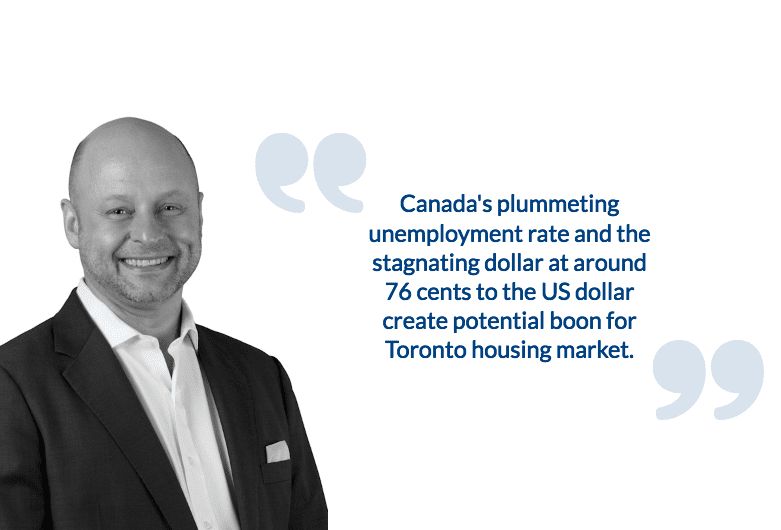For anyone expecting to see a downturn of Toronto’s housing market, the Canada Mortgage and Housing Corporation says 2017 won’t be the year.
At a recent condo seminar held by the CMHC, the group laid forth it’s predictions for the upcoming year. Jim Burtnick, a member of Torontoism, broker and senior vice president at Sotheby’s International Realty Canada, was in attendance. He says CMHC is pointing at rising prices and a somewhat dwindling supply, but the health of the market is expected to remain strong.
CMHC sees sales coming in somewhere between 100,000 properties sold and the 113,000 we saw in 2016. Burtnick says that’s not enough to call it a retraction.
Not so much a slow as a maintain-where-it’s-at. I mean, the difference between 110,000 and a 113,000 sales is not huge. That is three-thousand less than last year. So almost basically the same and it would be the third straight year where sales were above 100-thousand sales.
Shrinking Vacancy Rates And Condo Bidding Wars
One of the biggest impacts we’ll see in the coming months is on the rental market. CMHC says competition for condo rentals remains high.
“Literally there are people lining up,” says Burtnick. “Like if you put a condo out for rent you’re getting multiple people bidding on it.”
About 80,000 people move to the GTA every year. They come from overseas – Toronto attracts the highest number of immigrants in Canada – or from other provinces like Alberta and Newfoundland & Labrador where the falling price of oil has impacted those economies. That creates a lower vacancy rate.
Currently, as Burtnick points out, the vacancy rate is below one percent. But that could drive more builders into the sector.
A healthy market is somewhere in the neighbourhood of 4 percent. So you’re actually seeing some of these pension funds getting into the rental market and they’re building new purpose-built rental properties because that’s going to give them the kind of ROI on their fund that they need to finance their pensions.
Another of the CMHC’s predictions shows apartment resale inventory is dropping. That can lead to bidding wars, according to Burtnick, because there’s less condo inventory available.
He says that Toronto used to have around a 4-month supply of condos ready for new buyers, now that supply has dwindled to around 1.5. Because there are simply fewer options, people are willing to spend more.
READ MORE: WHO ARE THE CONDO BUYERS IN TORONTO?
Affordability And Rising Prices
While prices may not rise as much as they have in the last couple years, they’re still expected to head higher. That creates a problem for many first time homebuyers whose income is outpaced by the price of a new home.
High prices are causing more people to look at the GTA’s suburbs as a viable option for home buying. CMHC shows prices rising in the areas surrounding the downtown core by more than 20 percent, while Toronto-proper–where prices are already high–is expected to see a hike of a little more than 14 percent.
“The city’s become so expensive that the only options are outside the core so more people are looking out there and that’s driving up the price outside the core,” says Burtnick.
The CMHC also shows that high prices throughout the GTA are effectively pushing some would-be buyers out of the market. The downpayment for a home costs more than the average Torontonian makes.
Toronto’s becoming a city like Manhattan in New York, where you’ve got to have a lot of money to be able to afford to live there. They’re suggesting that, just based on fundamentals of people’s actual income versus the purchase price, it’s becoming problematic.
But what the CMHC’s numbers don’t show, according to Burtnick, is an increasing reliance on the Bank of Mom & Dad.
“A lot of parents are helping kids get into the marketplace,” says Burtnick. “So even if their income isn’t enough to justify the purchase price they’re supplying typically a health deposit so they can get a foothold on the real estate market.
There was a period a few years ago when many believed too many buildings were being built. It fed into fears of a bubble in the real estate market. Even today Burtnick says it’s not uncommon for people to point to the number of construction cranes and say the sky is falling.
But if supplies are dwindling to the point that bidding wars are common, or that it’s causing prices to rise so much that the average person simply can’t afford it, shouldn’t that show that we’re not building enough? According to Burtnick, neither is true. When he looks at the CMHC numbers he sees the city growing to fit it needs.
Certainly if you look at the overbuilding aspect, we’re not overbuilding in any stretch. We’re basically maintaining our natural need based both on immigration and based upon natural birth and death rates.
The reason that prices continue to rise in the GTA, putting even more pressure on buyers, is a lack of supply according to Burtnick. Getting through the approval process for new buildings simply takes too long.
“It’s taking too long for developers to get projects approved and shovels in the ground so that they can provide new inventory.”

Students from all over the world seek education in Ontario
Read more: top 6 universities for international students in ontario
Employment Growth vs. Shrinking Dollar
Looking at the broader picture, Canada’s unemployment rate continues to plummet, but the dollar has also stagnated around 76 cents to the US dollar. Burtnick sees that as a potential boon for Toronto’s housing market.
“What a lower dollar means is certainly Canada becomes more attractive from a point of view of an exchange rate,” he said. “So from a foreign point of view it makes us look on sale and relatively inexpensive.”
He points out that this could attract foreign buyers, but just as likely their may be Canadian expats looking to return to the market.
“They might see this as an opportunity to get a good bang for the buck, especially if they’re getting paid in US dollars.”
The tumult south of the border could have a further impact for the region as well. Canadian universities are reporting an influx of applications from the United States. A poll by the Globe and Mail reports a spike of between 20 and 80 percent for the 2017-18 academic year compared to the previous year.
But while it may be easier for students to come here, Burtnick doesn’t anticipate as many people coming looking for jobs.
It’s not like they can just come here and start working right away if they need to work. Because you’d have to have a work visa if you’re not a Canadian citizen. I think some people are looking for education coming up here. Certainly our education system is a lot more affordable than the US.

Toronto is experiencing influx of new residence not only from foreign countries, but also from other parts of Canada
The Interest Rate Question
One of the big questions over the last few years, and one that will continue into 2017, is when will the Bank of Canada raise interest rates? BoC governor Stephen Poloz has intimated that he has no plans to move rates given the unpredictable times we’re living in. But as Burtnick points out, the U.S. Secretary of Treasury Janet Yellen has intimated she could see as many as three rate hikes throughout the year.
That would attract investors to the U.S. bond market and although the Bank of Canada hasn’t raised their benchmark rate, for banks to raise money for mortgages they’re going to have to offer a better bond rate for people who are putting up the money for these mortgages. So if the US raises their benchmark rate I can see our mortgage rate going up.
Regardless of what happens on the international stage, Toronto’s housing market still looks like a safe investment to many buyers. An equilibrium has been reached between supply and demand that creates opportunity for investors, but still leaves some room for new buyers to join in on the fun.
TT00ML






